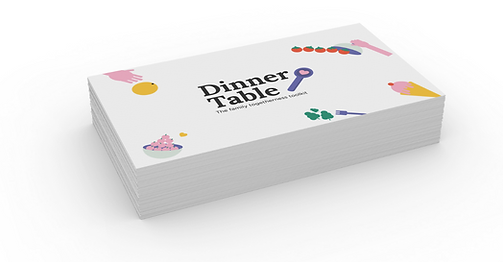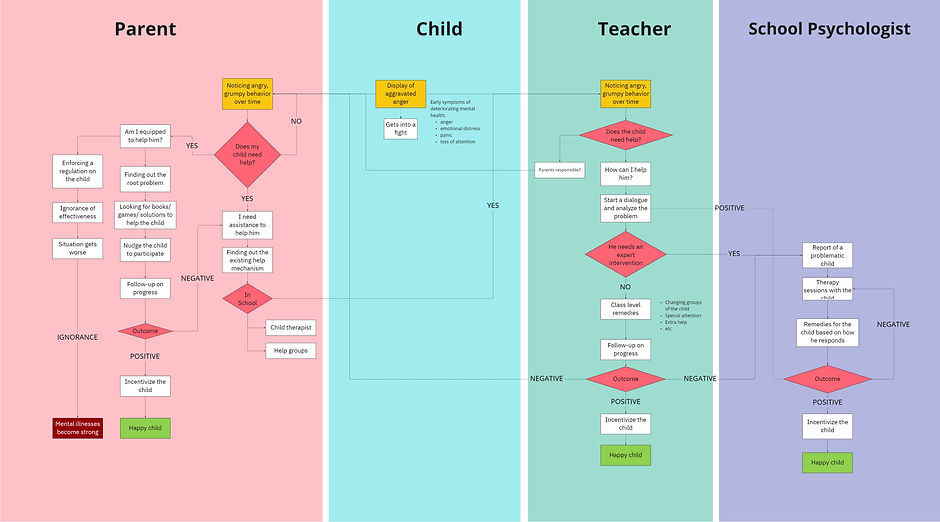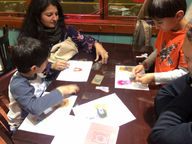"Change in context brings changes in the content" - Prof. Anil Gupta
Dinner Table
Dinner Table is an interactive toolkit that consists of activities, games and a manual for parents and children to bond, build trust, and navigate difficult conversations.
Part of coursework for the Managing Creative Projects and Teams at Parsons, this project was an introspective experience to my design fundamentals and leadership abilities.
TEAM
Soumil Panwar, Anamika Gopi, Brielle Yang, E Ouyang, Madhura Redij, Sara Rebello, Sharvari Sovani, Zainab Akhtar
COURSE INSTRUCTOR
Lena Koropey
DURATION
15 Weeks
Process
We followed the double diamond model to propose a strategic recomendation to the client partner.
IMMERSION
SYNTHESIS
IDEATION, PROTOTYPING AND TESTING
Dove into secondary research to build context around mental health among children and break down goals into actionable research strategy
Interviewed various expert psychologists and parents to find insights, pain points and motivations of the children- parent family unit to formulate opportunity statements
Conducted sprint-like idea generation sessions with peer brainstorming sessions and hypothesis testing workshops with parent-child groups. Built final physical prototype to pitch as a business case and tested with 6 families to absorb feedback and iterate.
Children and Mental Health
8.4%
“Ever having been diagnosed with either anxiety or depression” among children aged 6–17 years increased from 5.4% in 2003 to 8% in 2007 and 8.4% in 2011–2012
6.4%
“Ever having been diagnosed with anxiety” increased from 5.5% in 2007 to 6.4% in 2011–2012
4.9%
“Ever having been diagnosed with either anxiety or depression” among children aged 6–17 years increased from 5.4% in 2003 to 8% in 2007 and 8.4% in 2011–2012
22%
Among children living below 100% of the federal poverty level, more than 1 in 5 (22%) had a mental, behavioral, or developmental disorder
7.1%
of children aged 3-17 years (approximately 4.4 million) have been diagnosed with anxiety

School Psychologists and Their Role
We tried to visualize the mental health system in a public school system, the various roles and connections within the system and identified various stakeholders. Even though their contributions in the life of a child might be extremely helpful, identification and analysis of early symptoms of complicated conditions is still a responsibility for the parents.
Click image to View Detailed Artefact
Causes for Mental Health Issues in Children
We immersed into literature to identify the causes of mental health issues to gauge if this problem can be solved at all.
Heridity
Biology
Trauma
Stress
Many mental disorders run in families, suggesting that the disorders, or more accurately, a vulnerability to the disorders, might be passed on from parents to children through genes.
As in adults, many mental disorders in children have been linked to abnormal functioning of particular brain regions that control emotion, thinking, perception, and behavior. Head traumas also can sometimes lead to changes in mood and personality.
Some mental disorders might be triggered by psychological trauma, such as severe emotional, physical, or sexual abuse; an important early loss, such as the loss of a parent; and neglect.
Stressful or traumatic events can trigger a disorder in a person with a vulnerability to a mental disorder.
User Persona

Journey Map
We tried to visualize the life of Sam throughout his day at home and school. We imagined the difficulties and obstacles he faces, ranging from dealing with pressure from his family at home, performing better academically to his teachers at school being disappointed in him. As a result, he acts out and alienates his classmates, leaving him feeling sad and alone. Through this journey map, we were able to plot Sam’s feelings along with his daily experience.
Click image to View Detailed Artefact
Target Audience

Primary Stakeholders
10-14 year old children
-
Public school students with limited access to mental health resources
-
Showing early onset symptoms of depression and anxiety
-
(uncontrolled emotions, bursts of anger, lack of focus, low energy, unmotivated etc.)
Secondary Stakeholders
Parents of 10-14 year old children
-
They have a direct impact into the day to day activities of a child
-
Potential to act as facilitators of a solution as they care for the child
Key Insights: Research Synthesis

Opportunity Statements for Ideation
.jpg)
How Might We
Create an engaging non digital experience
How Might We
Develop a game to encourage open communication between parents and children
How Might We
Develop an awareness about feelings and emotions
How Might We
Build trust among parents and children through activities
Design Criteria
With analytical brainstorming, we came up with mandates for solutioning in terms of netotiables and non-negotiable values to translate into our action from here.
MUST
SHOULD
COULD
WON'T
-
Facilitate communication and trust
-
Be fun and good for long term repeated use
-
Be tailored to both parents and children
-
Promote non-digital solutions/activities
-
Adapt to larger groups of people
-
Connect games and activities together
-
Expand scope to different audiences & age groups
-
Have hyper-competitive or argumentative games
Brainstorming with Workshops
Goal
Fostering a collaborative approach to finding solutions to ‘how might children be aware of, articulate and communicate their feelings and emotions better’ where participants participate in activities and generate solutions to the given problem space.
Workshop Participants
A group of 10 international students from around the world intended to bring up varied examples of parent-child bonding and learning from their experiences.
_edited.jpg)
Activity 1
Logistics
Participants were provided with a positive statement on pieces of paper. This was intended for them to recollect happy memories with their loved ones and express themselves on post-its.
Goal
This activity builds upon nostalgia and sets an emotional context for the entirety of the workshop. We also learn about childhood memories with their parents that people cherish and remember.

Result
-
Participants who have spent more time with their parents feel a greater connection with them
-
Special memories were being a part of everyday activities with family such as cooking, playing board games, going on vacation, etc.
-
These memories are special not so much because of the activity, but because of the bond that they build
Activity 2
Logistics
Participants were provided with a simple persona. Below these personas was a need statement framed to probe into mitigating urgent problems for the particular persona. After 15 minutes into the exercise, we gave additional constraints to the situation built to dig deeper.
Goal
This activity brings out a large number of ideas that solve the problems we have identifies. These ideas might be a ground for our solution as they solve the critical problems we identified


Result
-
All participants agreed to generalize and de-stigmatizing seeking professional help for children
-
Most participants agreed that parents and adults need to intervene in situations to help children with their struggles
-
Communication with an elder was highlighted as a common ground for all the ideas
-
Multiple participants suggested that professional therapy and guidance should be introduced into the child’s schedule
-
Participants showcased a deep internalization of problems and the ideas were coming from personal experiences
Value Proposition
Facilitating trust, awareness and communication between parents and children around mental health and welbeing.
BUILDING TRUST
_edited.jpg)
INCREASING AWARENESS

PROMOTING COMMUNICATION
The Solution
.jpg)


Dinner Table is an interactive toolkit that consists of activities, games and a manual for parents and children to bond, build trust, and navigate difficult conversations.
Developed with children at the forefront by co-creating a diverse realm of games, these immersive tools aim to develop empathy and compassion leading to better insights into the life of children.
How it works
When families receive the Dinner Table Toolkit, they are encouraged to explore its contents as each of the three components serve different purposes. Through active participation in the activities in this toolkit, children and parents will continue to bond with each other, creating the strong foundations of a healthy family relationship.
.png)
Dinner Table Manual
Table Talk Cardgame
Show Me Your Face
The Manual
Table Talk Cardgame
Show me Your Face Cardgame
Purpose: Encourage Conversations
This game allows families to participate in a lengthier activity that will continue to build on communication developed in other aspects of the toolkit. During this game, families will have a chance to negotiate with each other and be able to create stories pertaining to each of their pieces of art. It will allow each family member to express his or her thoughts and ideas to one another, encouraging communication.
.png)
.png)
Purpose: Build Trust
Families can play Table Talk anywhere and anytime. The simple instructions and ease of the materials make it the perfect game for a night-in or a great activity to travel with. This game provides many opportunities for families to engage in conversations they may not have otherwise. Through this game, families are provided with the opportunity to better know each other and to build an atmosphere of trust.
.png)
Purpose: Improve Awareness
The manual is intended to be read through by multiple members of a family or it can be reviewed individually. The manual will include multiple mindful resources and engaging comics, which will improve awareness of the importance of communication and how to properly engage in conversations with family members.
Prototype Testing

Over 3 weeks, we tested our key hypothesis and various assumptions with various target users over zoom and in person. This was taken up as an iterative exercise alongside concept development to bring in feedback into the design process at earlier stages. This approach helped us inform design intent with genuine feedback to help in making critical decisions.
Hypothesis
-
Can the toolkit be used consistently and repeatedly?
-
Is the toolkit more effective as a whole set, rather than the individual components?
-
How much more does our toolkit facilitate comfort and communication beyond the average game?
.jpeg)
Key Learnings
I realized that being an initiator and risk taker are an integral part of a designer's role while working with complex problems and large teams. This was the first time that I led a team of 8 extremely talented designer and catalyzed conversations that helped bring out the best solution, resolve conflicts, manage work healthily and being the best team mates ever.
I discovered that bringing users into the design process is practical and instrumental in navigating away from the usual biases and concepts. This brought a lot of efficiency in terms of project management and timelines.
Key Learnings






